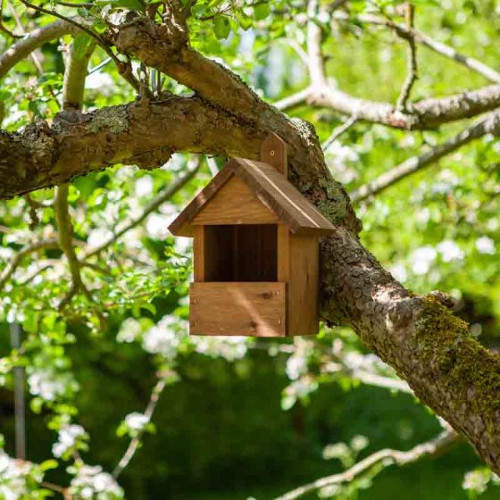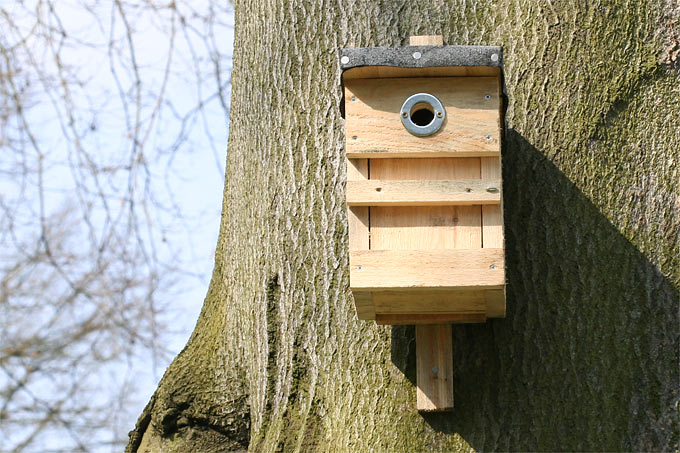With a nesting box you provide birds with a cozy home, which, unfortunately, due to the increasing civilization is increasingly rare to find. With cheerful singing and colorful activity, the animals will thank you. So why not hang up several breeding sites at once? However, you should keep in mind that birds also prefer a certain distance from their neighbors. How big the distance to a neighboring bird house should be, you can read on this page.
Bird boxes can be placed relatively close together, but the spacing should be carefully considered to avoid overcrowding and territorial disputes among nesting birds. The specific spacing between bird boxes largely depends on the bird species you’re trying to attract and their social behavior. Here are some general guidelines for spacing bird boxes:
- Species-Specific Requirements: Different bird species have different requirements for nesting territory. Some are more territorial and need more space, while others are more social and tolerant of neighbors. Research the specific species you want to attract to determine their ideal spacing.
- Spacing for Cavity-Nesting Birds: Cavity-nesting birds, like bluebirds and chickadees, often tolerate boxes placed 100 to 200 feet apart. However, in some cases, you can place them as close as 10 to 15 feet apart if the birds are social and non-territorial.
- Territorial Species: Species like bluebirds are territorial and prefer their space. Spacing bluebird boxes at least 100 to 200 feet apart is recommended to reduce territorial disputes.
- Social Species: Some birds, such as Purple Martins, are more social and nest in colonies. For these species, you can place bird boxes closer together, often just a few feet apart.
- Height: When placing multiple bird boxes on the same pole or support structure, vary the height to prevent one box from shading or otherwise interfering with another.
- Mixed Species: If you intend to attract a variety of bird species to your garden, provide a mix of box sizes and types to accommodate their different nesting requirements.
- Spacing for Non-Nesting Boxes: If you’re installing boxes that are not intended for nesting but rather for roosting or winter shelter (e.g., roosting boxes for owls), you can place them closer together since they won’t be competing for nesting territory.
- Monitor and Adjust: Regularly monitor the bird boxes to ensure they are not overcrowded. If you observe signs of territorial disputes or competition, consider adjusting the spacing between boxes.
In summary, the ideal spacing for bird boxes depends on the species you want to attract and their social behavior. Be sure to research the specific requirements of the birds you wish to host and adjust the spacing accordingly to provide a suitable and comfortable nesting environment.
Contents
The right distance
The Nature and Biodiversity Conservation Union recommends a distance of at least ten meters for the birds to feel comfortable. The necessity is based on the breeding behavior of the animals. Especially during the breeding season, numerous species claim their own territory in which they do not tolerate intruders. The appropriate distance prevents competitive fights.
The situation is different with nest boxes for different bird species. The animals do not regard each other as rivals, but still need their own “privacy” of about three meters.
Exceptions
Only sparrows and starlings, which are quite comfortable in company.
Different heights
Several nesting boxes in the garden increase the species richness of visitors. But each bird species makes different demands on the home provided. Therefore, you should not only consider the distance horizontally, but also install the birdhouses at different heights.
Note: In general, you should provide a height of 1.5-2 meters to give cats no chance to reach the entrance hole. Also, the entrance hole should never be exactly at eye level, so that the birds do not feel observed.
Number of nest boxes
Many nest boxes in the garden look nice, but sometimes do not fulfill the desired benefit. If the conditions are not right, the home is often not occupied. The quantity of birdhouses depends on
- the space available
- the species diversity of your region
- the surrounding supply of breeding sites
- the available food supply
Tips for hanging nest boxes

Would you like to check whether your garden or balcony is a suitable place for a nest box? Or have you already bought a nest box but don’t know exactly where it should be hung? These tips will help you find the right place for your nest box so that hopefully it will be quickly accepted and inhabited by birds.
Tips For Placement And Orientation Of Nest Boxes:
- It is important to choose a quiet location that is difficult for cats and other nest predators to access. Minimum height here is 1.5 to 2 feet.
- Make sure that the nest box is installed in a place protected from wind, rain and sun. If possible, orient the entrance opening to the east or southeast – in any case, avoid an orientation to the west (weather side) and to the south, so that the nest box does not hang in the full sun.
- Hanging your nest box near shrubbery will help young birds when they make their first attempts to fly. Branches and twigs provide good places for them to take off and land, and foliage provides good shelter. However, be sure to provide an approach that is free of obstructions.
- Nest boxes with open fronts (half-caves, half-open nest boxes) provide less protection than closed nest boxes and should be hung in a sheltered location to be safe from predators. Climbing plants that partially cover the nest boxes are ideal for this purpose.
- The number of boxes you should hang depends primarily on the available food supply: If there is enough food, water, and ample shelter and cover in your yard, you can hang several nest boxes. However, pay attention to what kind of bird species visit your garden, because some species need more distance from each other:
- Hang several nest boxes next to each other for so-called colony breeders, such as house martins, house sparrows, starlings and swifts.
- Do not position the nest boxes too close together. Nest boxes for different bird species, for example, blue tit and great tit, must have a minimum spacing of three meters. Nest boxes of the same type should be hung at least 10 meters apart. The reason is that many bird species have a fixed territory during the breeding season that they defend against intruders. With proper spacing between nest boxes, you will avoid conflicts.
- To attach to a tree trunk, it is best to use an aluminum nail. This will prevent damage to the tree.
- Do not fill the nest box with nesting material, such as straw or sawdust. Birds build their own nests in the nest box, using different materials and construction methods.
- If the nest box remains unoccupied for two breeding seasons, hang it in another suitable place.
When Is The Best Time To Hang A Nest Box?
It is well known that the breeding season of garden birds takes place in the spring months – however, this is not the only time when it makes sense to hang a nest box. After all, these animals also need a shelter in autumn and winter.
It is during these months that you can help your garden birds by hanging one or more nest boxes. Because with it you offer the birds protection from rain and a cozy place in cold winter nights. But the inhospitable weather is not the only reason to hang nest boxes, especially in autumn: Garden birds also get to know the nesting cavities in the surrounding area during this time. And many birds like to return to the place where they found shelter in the winter to start a family in the spring. So if you hang a few nest boxes in your yard as early as fall, they’re much more likely to be inhabited in the spring.
Some bird species start breeding very early, for example the tawny owl. Therefore, hang a nest box for these birds no later than the end of December.


